The Story Behind the Photograph
How I photographed the Waterhole
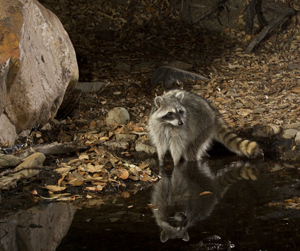
In the January-February Tip of the Month I discussed a new infra-red remote camera firing system, the Range IR produced by Cognisys. Then, in last month's Story Behind the Photograph I illustrated this product in use when I photographed the Bushbabies and genets in Kenya. Because of packing considerations (luggage!) I limited myself to just one Range IR and I didn't use the companion piece, the ultimate controller for the device called the Stop Shot, also produced by Cognisys.
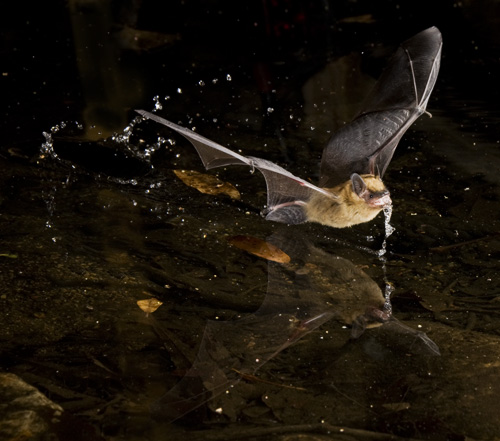
On our Arizona Hummingbird and Bat Photo Shoot we photograph hummingbirds around our lodge, and we photograph bats at one to three different locations, depending upon wind, water conditions, and some other factors. In good years, the stream that runs behind our lodge is almost dry by the time of our shoots, and the pools that remain can be great for bats. This year, although we did some bat photography here, there was enough water in other portions of the stream that bats could drink virtually anywhere, and consequently our shooting here was limited.
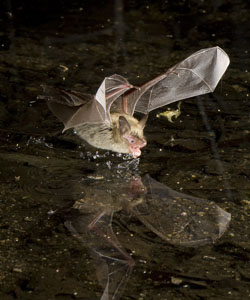
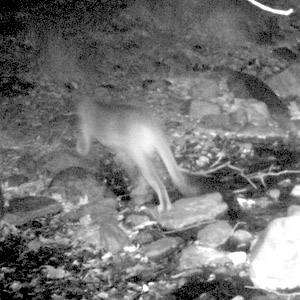
Various Myotis bats drinking at the waterhole behind our lodge, and a Mountain Lion or Puma that passed within 200 yards of our lodge as it visited a roadkill deer (this, shot with a Moultrie Game camera).
However, although the bats were less common than in some years, I found I had another target -- the potential of a Puma or mountain lion. With a Moultrie Game or Trail Camera I had photographed a puma that investigated a road kill deer that I found only about 200 yards upstream from our lodge. I was hoping that the puma might pass through again, and perhaps visit the waterhole. Consequently, once we finished photographing bats at that pool I set up for a waterhole and mammal set.
Although I could have used a single Range IR, I decided instead to use two, paired together to give a broader coverage for triggering my camera system. When using two, the StopShot must be incorporated as well, and I was anxious to actually try out this device in a field situation.
If you look at the Cognisys web site, there is a bit of coverage about shooting water drops using the StopShot, and while that's neat it could also potentially produce a false impression that the StopShot is for studio work. It's not, as it is far more versatile than this and I wanted to finally put the StopShot through some paces.
Here's why. The StopShot allows you to time out a camera, so that if a subject breaks a beam repeatedly the camera doesn't fire repeatedly, unless you enable it to do so. Instead, you can program the StopShot to time-out or disable the camera from firing for a period of time. This time out period can be coordinated with the recycle time of a flash, giving the flash time to charge back up. Otherwise, what may happen is a subject might break a beam and repeatedly trigger the camera, causing the flash to fire repeatedly and, in doing so, eventually make progressively darker exposures since the flash can't recycle fast enough.
For these shots I rigged up a nine flash system, using relatively inexpensive Vivitar flashes that I wired in series so that when the camera fired, all the flashes would fire at exactly the same time. Attaching the flashes to slaves may have accomplished the same result, but even some resistance or delay amongst the slaves could cause a micro-second staggering that, in some situations, might result in less crisp images. Honestly, I might be wrong here, but my own results with hummingbirds, in years past using the slaves, led me to this conclusion. Hard-wired, I haven't had this issue.
I positioned my two Range IRs so that the infrared beams covered the opposite side of the waterhole, and attached to the StopShot I programmed in a two-second delay between the times the camera could fire.
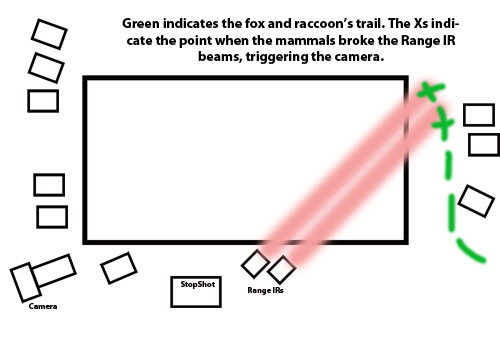
In the illustration above, the empty boxes represent the approximate positions of the nine flashes. The three on the far right created the strong back-lighting, while the flashes on the left filled in the light, for the front lighting. None of these flashes were 'on axis' with my camera lens, so I did not have to worry about red-eye from my mammal subjects.
I set the flashes on manual, and dialed in a 1/16th power ratio so that the flashes would maintain their power and recycle quickly. With my ISO at 800, and by using so many flashes, I had enough light to use f11, giving me plenty of depth-of-field.
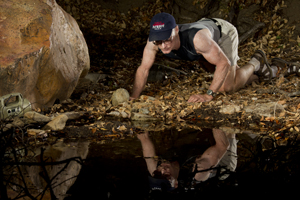
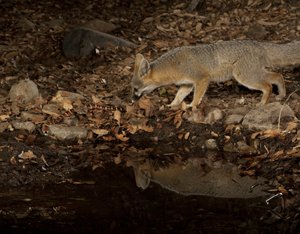
That's me testing out the lighting and the Range IR system. When everything is set up, the LAST thing you should do before leaving the area is do a final 'trip' to make sure everything is firing. Then, if something does come in you know you're armed and ready.
One of the most important things to do, once everything is set up, is test the system, and I crawled along several times, tripping the system. Doing so I not only tested my aiming of the Range IRs but also my lighting. I wanted to create a strong back-lighting on anything that came in to my ideal position, which also modeled the boulder on the left.
Unfortunately I discovered my puma rather late in our Photo Shoot in Arizona, so I only had a few days to set up and attempt shots. During that time I succeeded in photographing a very blase' Raccoon and a very skittish Gray Fox. The raccoon wasn't bothered by the flashes and I made numerous images, but the fox only stayed for one flash, and then was gone. Using an infrared Moultrie Game Camera on previous days I knew that the fox would spend a lot of time at the waterhole, but apparently not when a flash fired.
It is important to note that my waterhole was just one of any number of waterholes or stretches ofopen water in the stream bed where a shy gray fox could drink. So, although my fox would visit this waterhole and then, I suspect, run off, it wasn't deprived of water. Just a few yards in either direction brought it to more water, and these water sources continued for hundreds of yards in any direction.
Last year, at another water set I positioned right outside our room, the fox that visited simply couldn't have cared less, and always stayed for multiple shots. This year's fox was shy, and illustrates you just never know what type of success you'll have.
If you're interested in learning more about using flash effectively and creatively, please contact our office and ask to be placed on our notification list for our Advanced Nature Photo Course - The Flash Course. I offer this course every few years, and might do so again next year if there is a demand.
Otherwise, you might consider doing our Hummingbird, Bat, and Night Photography Photo Shoot next year in Arizona. I don't have that brochure completely written yet, but if you refer to my 2012 brochure on Hummingbirds and Bats, you'll get a rough, though somewhat incomplete, idea of what we'll be doing. I envision my participants having their own Range IRs (a $175 investment) and a few flashes that they can set up in the canyon, or at Kangaroo Rat nests, or water holes or game trails, where they can learn how to use this equipment while, hopefully, capturing some neat subjects. Those subjects could include Bobcats, Coatimundis, Ringtails, Raccoons, Pumas, Whitetail Deer, Javelina, and even Illegal Aliens! We'll also be doing light-painting of Saguaro cactuses with star scapes, star-trails, and the usual, with bats and hummingbirds, too.

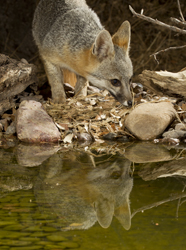
You never know what you'll capture when you're using a camera trap system. The raccoon was captured at the waterhole, while the gray fox was shot at an artificial waterhole I had placed right outside our rooms at the lodge.
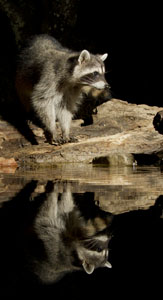


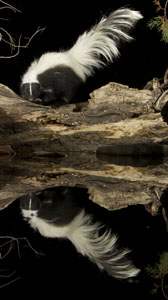
Some of the other subjects we've filmed at night, in previous years. We suspect we'll have luck with many of these next year on our special night photography sessions.
Personally, I hope that next year we'll have luck with some really exciting subjects -- like a bobcat or a puma. Jaguars have been reported in these mountains, as have ocelots and jagarundis, so you never know. I know how to do this, now I just need some luck!
Past Stories Behind the Photograph
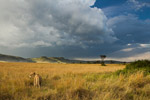

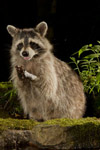
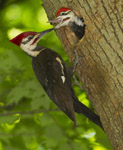


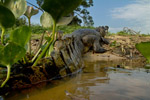
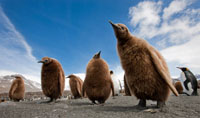
.jpg)
Bushbaby
Barn Swallow
King Penguin
The Lion and the Landscape
The Bighorn Sheep
The Raccoon
The Pileated Woodpecker
The Striking Rattlesnake
The Pink Salmon
The Spectacled Caimen
Check out our latest web site,
mcdonaldwildlifephotos.com
where we'll be adding portfolios and eventually building up
a searchable data base for photo buyers. We've just started,
and the selection is limited, but it is still worth a visit!
Office Phone: (717) 543-6423
Or FAX us at: (717) 543-5342
The Story Behind the Photograph
How I photographed the Waterhole

In the January-February Tip of the Month I discussed a new infra-red remote camera firing system, the Range IR produced by Cognisys. Then, in last month's Story Behind the Photograph I illustrated this product in use when I photographed the Bushbabies and genets in Kenya. Because of packing considerations (luggage!) I limited myself to just one Range IR and I didn't use the companion piece, the ultimate controller for the device called the Stop Shot, also produced by Cognisys.

On our Arizona Hummingbird and Bat Photo Shoot we photograph hummingbirds around our lodge, and we photograph bats at one to three different locations, depending upon wind, water conditions, and some other factors. In good years, the stream that runs behind our lodge is almost dry by the time of our shoots, and the pools that remain can be great for bats. This year, although we did some bat photography here, there was enough water in other portions of the stream that bats could drink virtually anywhere, and consequently our shooting here was limited.


Various Myotis bats drinking at the waterhole behind our lodge, and a Mountain Lion or Puma that passed within 200 yards of our lodge as it visited a roadkill deer (this, shot with a Moultrie Game camera).
However, although the bats were less common than in some years, I found I had another target -- the potential of a Puma or mountain lion. With a Moultrie Game or Trail Camera I had photographed a puma that investigated a road kill deer that I found only about 200 yards upstream from our lodge. I was hoping that the puma might pass through again, and perhaps visit the waterhole. Consequently, once we finished photographing bats at that pool I set up for a waterhole and mammal set.
Although I could have used a single Range IR, I decided instead to use two, paired together to give a broader coverage for triggering my camera system. When using two, the StopShot must be incorporated as well, and I was anxious to actually try out this device in a field situation.
If you look at the Cognisys web site, there is a bit of coverage about shooting water drops using the StopShot, and while that's neat it could also potentially produce a false impression that the StopShot is for studio work. It's not, as it is far more versatile than this and I wanted to finally put the StopShot through some paces.
Here's why. The StopShot allows you to time out a camera, so that if a subject breaks a beam repeatedly the camera doesn't fire repeatedly, unless you enable it to do so. Instead, you can program the StopShot to time-out or disable the camera from firing for a period of time. This time out period can be coordinated with the recycle time of a flash, giving the flash time to charge back up. Otherwise, what may happen is a subject might break a beam and repeatedly trigger the camera, causing the flash to fire repeatedly and, in doing so, eventually make progressively darker exposures since the flash can't recycle fast enough.
For these shots I rigged up a nine flash system, using relatively inexpensive Vivitar flashes that I wired in series so that when the camera fired, all the flashes would fire at exactly the same time. Attaching the flashes to slaves may have accomplished the same result, but even some resistance or delay amongst the slaves could cause a micro-second staggering that, in some situations, might result in less crisp images. Honestly, I might be wrong here, but my own results with hummingbirds, in years past using the slaves, led me to this conclusion. Hard-wired, I haven't had this issue.
I positioned my two Range IRs so that the infrared beams covered the opposite side of the waterhole, and attached to the StopShot I programmed in a two-second delay between the times the camera could fire.

In the illustration above, the empty boxes represent the approximate positions of the nine flashes. The three on the far right created the strong back-lighting, while the flashes on the left filled in the light, for the front lighting. None of these flashes were 'on axis' with my camera lens, so I did not have to worry about red-eye from my mammal subjects.
I set the flashes on manual, and dialed in a 1/16th power ratio so that the flashes would maintain their power and recycle quickly. With my ISO at 800, and by using so many flashes, I had enough light to use f11, giving me plenty of depth-of-field.


That's me testing out the lighting and the Range IR system. When everything is set up, the LAST thing you should do before leaving the area is do a final 'trip' to make sure everything is firing. Then, if something does come in you know you're armed and ready.
One of the most important things to do, once everything is set up, is test the system, and I crawled along several times, tripping the system. Doing so I not only tested my aiming of the Range IRs but also my lighting. I wanted to create a strong back-lighting on anything that came in to my ideal position, which also modeled the boulder on the left.
Unfortunately I discovered my puma rather late in our Photo Shoot in Arizona, so I only had a few days to set up and attempt shots. During that time I succeeded in photographing a very blase' Raccoon and a very skittish Gray Fox. The raccoon wasn't bothered by the flashes and I made numerous images, but the fox only stayed for one flash, and then was gone. Using an infrared Moultrie Game Camera on previous days I knew that the fox would spend a lot of time at the waterhole, but apparently not when a flash fired.
It is important to note that my waterhole was just one of any number of waterholes or stretches ofopen water in the stream bed where a shy gray fox could drink. So, although my fox would visit this waterhole and then, I suspect, run off, it wasn't deprived of water. Just a few yards in either direction brought it to more water, and these water sources continued for hundreds of yards in any direction.
Last year, at another water set I positioned right outside our room, the fox that visited simply couldn't have cared less, and always stayed for multiple shots. This year's fox was shy, and illustrates you just never know what type of success you'll have.
If you're interested in learning more about using flash effectively and creatively, please contact our office and ask to be placed on our notification list for our Advanced Nature Photo Course - The Flash Course. I offer this course every few years, and might do so again next year if there is a demand.
Otherwise, you might consider doing our Hummingbird, Bat, and Night Photography Photo Shoot next year in Arizona. I don't have that brochure completely written yet, but if you refer to my 2012 brochure on Hummingbirds and Bats, you'll get a rough, though somewhat incomplete, idea of what we'll be doing. I envision my participants having their own Range IRs (a $175 investment) and a few flashes that they can set up in the canyon, or at Kangaroo Rat nests, or water holes or game trails, where they can learn how to use this equipment while, hopefully, capturing some neat subjects. Those subjects could include Bobcats, Coatimundis, Ringtails, Raccoons, Pumas, Whitetail Deer, Javelina, and even Illegal Aliens! We'll also be doing light-painting of Saguaro cactuses with star scapes, star-trails, and the usual, with bats and hummingbirds, too.


You never know what you'll capture when you're using a camera trap system. The raccoon was captured at the waterhole, while the gray fox was shot at an artificial waterhole I had placed right outside our rooms at the lodge.




Some of the other subjects we've filmed at night, in previous years. We suspect we'll have luck with many of these next year on our special night photography sessions.
Personally, I hope that next year we'll have luck with some really exciting subjects -- like a bobcat or a puma. Jaguars have been reported in these mountains, as have ocelots and jagarundis, so you never know. I know how to do this, now I just need some luck!
Past Stories Behind the Photograph








.jpg)
Bushbaby
Barn Swallow
King Penguin
The Lion and the Landscape
The Bighorn Sheep
The Raccoon
The Pileated Woodpecker
The Striking Rattlesnake
The Pink Salmon
The Spectacled Caimen
Check out our latest web site,
mcdonaldwildlifephotos.com
where we'll be adding portfolios and eventually building up
a searchable data base for photo buyers. We've just started,
and the selection is limited, but it is still worth a visit!
Office Phone: (717) 543-6423
Or FAX us at: (717) 543-5342
The Story Behind the Photograph
How I photographed the Waterhole

In the January-February Tip of the Month I discussed a new infra-red remote camera firing system, the Range IR produced by Cognisys. Then, in last month's Story Behind the Photograph I illustrated this product in use when I photographed the Bushbabies and genets in Kenya. Because of packing considerations (luggage!) I limited myself to just one Range IR and I didn't use the companion piece, the ultimate controller for the device called the Stop Shot, also produced by Cognisys.

On our Arizona Hummingbird and Bat Photo Shoot we photograph hummingbirds around our lodge, and we photograph bats at one to three different locations, depending upon wind, water conditions, and some other factors. In good years, the stream that runs behind our lodge is almost dry by the time of our shoots, and the pools that remain can be great for bats. This year, although we did some bat photography here, there was enough water in other portions of the stream that bats could drink virtually anywhere, and consequently our shooting here was limited.


Various Myotis bats drinking at the waterhole behind our lodge, and a Mountain Lion or Puma that passed within 200 yards of our lodge as it visited a roadkill deer (this, shot with a Moultrie Game camera).
However, although the bats were less common than in some years, I found I had another target -- the potential of a Puma or mountain lion. With a Moultrie Game or Trail Camera I had photographed a puma that investigated a road kill deer that I found only about 200 yards upstream from our lodge. I was hoping that the puma might pass through again, and perhaps visit the waterhole. Consequently, once we finished photographing bats at that pool I set up for a waterhole and mammal set.
Although I could have used a single Range IR, I decided instead to use two, paired together to give a broader coverage for triggering my camera system. When using two, the StopShot must be incorporated as well, and I was anxious to actually try out this device in a field situation.
If you look at the Cognisys web site, there is a bit of coverage about shooting water drops using the StopShot, and while that's neat it could also potentially produce a false impression that the StopShot is for studio work. It's not, as it is far more versatile than this and I wanted to finally put the StopShot through some paces.
Here's why. The StopShot allows you to time out a camera, so that if a subject breaks a beam repeatedly the camera doesn't fire repeatedly, unless you enable it to do so. Instead, you can program the StopShot to time-out or disable the camera from firing for a period of time. This time out period can be coordinated with the recycle time of a flash, giving the flash time to charge back up. Otherwise, what may happen is a subject might break a beam and repeatedly trigger the camera, causing the flash to fire repeatedly and, in doing so, eventually make progressively darker exposures since the flash can't recycle fast enough.
For these shots I rigged up a nine flash system, using relatively inexpensive Vivitar flashes that I wired in series so that when the camera fired, all the flashes would fire at exactly the same time. Attaching the flashes to slaves may have accomplished the same result, but even some resistance or delay amongst the slaves could cause a micro-second staggering that, in some situations, might result in less crisp images. Honestly, I might be wrong here, but my own results with hummingbirds, in years past using the slaves, led me to this conclusion. Hard-wired, I haven't had this issue.
I positioned my two Range IRs so that the infrared beams covered the opposite side of the waterhole, and attached to the StopShot I programmed in a two-second delay between the times the camera could fire.

In the illustration above, the empty boxes represent the approximate positions of the nine flashes. The three on the far right created the strong back-lighting, while the flashes on the left filled in the light, for the front lighting. None of these flashes were 'on axis' with my camera lens, so I did not have to worry about red-eye from my mammal subjects.
I set the flashes on manual, and dialed in a 1/16th power ratio so that the flashes would maintain their power and recycle quickly. With my ISO at 800, and by using so many flashes, I had enough light to use f11, giving me plenty of depth-of-field.


That's me testing out the lighting and the Range IR system. When everything is set up, the LAST thing you should do before leaving the area is do a final 'trip' to make sure everything is firing. Then, if something does come in you know you're armed and ready.
One of the most important things to do, once everything is set up, is test the system, and I crawled along several times, tripping the system. Doing so I not only tested my aiming of the Range IRs but also my lighting. I wanted to create a strong back-lighting on anything that came in to my ideal position, which also modeled the boulder on the left.
Unfortunately I discovered my puma rather late in our Photo Shoot in Arizona, so I only had a few days to set up and attempt shots. During that time I succeeded in photographing a very blase' Raccoon and a very skittish Gray Fox. The raccoon wasn't bothered by the flashes and I made numerous images, but the fox only stayed for one flash, and then was gone. Using an infrared Moultrie Game Camera on previous days I knew that the fox would spend a lot of time at the waterhole, but apparently not when a flash fired.
It is important to note that my waterhole was just one of any number of waterholes or stretches ofopen water in the stream bed where a shy gray fox could drink. So, although my fox would visit this waterhole and then, I suspect, run off, it wasn't deprived of water. Just a few yards in either direction brought it to more water, and these water sources continued for hundreds of yards in any direction.
Last year, at another water set I positioned right outside our room, the fox that visited simply couldn't have cared less, and always stayed for multiple shots. This year's fox was shy, and illustrates you just never know what type of success you'll have.
If you're interested in learning more about using flash effectively and creatively, please contact our office and ask to be placed on our notification list for our Advanced Nature Photo Course - The Flash Course. I offer this course every few years, and might do so again next year if there is a demand.
Otherwise, you might consider doing our Hummingbird, Bat, and Night Photography Photo Shoot next year in Arizona. I don't have that brochure completely written yet, but if you refer to my 2012 brochure on Hummingbirds and Bats, you'll get a rough, though somewhat incomplete, idea of what we'll be doing. I envision my participants having their own Range IRs (a $175 investment) and a few flashes that they can set up in the canyon, or at Kangaroo Rat nests, or water holes or game trails, where they can learn how to use this equipment while, hopefully, capturing some neat subjects. Those subjects could include Bobcats, Coatimundis, Ringtails, Raccoons, Pumas, Whitetail Deer, Javelina, and even Illegal Aliens! We'll also be doing light-painting of Saguaro cactuses with star scapes, star-trails, and the usual, with bats and hummingbirds, too.


You never know what you'll capture when you're using a camera trap system. The raccoon was captured at the waterhole, while the gray fox was shot at an artificial waterhole I had placed right outside our rooms at the lodge.




Some of the other subjects we've filmed at night, in previous years. We suspect we'll have luck with many of these next year on our special night photography sessions.
Personally, I hope that next year we'll have luck with some really exciting subjects -- like a bobcat or a puma. Jaguars have been reported in these mountains, as have ocelots and jagarundis, so you never know. I know how to do this, now I just need some luck!
Past Stories Behind the Photograph








.jpg)
Bushbaby
Barn Swallow
King Penguin
The Lion and the Landscape
The Bighorn Sheep
The Raccoon
The Pileated Woodpecker
The Striking Rattlesnake
The Pink Salmon
The Spectacled Caimen
Check out our latest web site,
mcdonaldwildlifephotos.com
where we'll be adding portfolios and eventually building up
a searchable data base for photo buyers. We've just started,
and the selection is limited, but it is still worth a visit!
Office Phone: (717) 543-6423
Or FAX us at: (717) 543-5342
The Story Behind the Photograph
How I photographed the Waterhole

In the January-February Tip of the Month I discussed a new infra-red remote camera firing system, the Range IR produced by Cognisys. Then, in last month's Story Behind the Photograph I illustrated this product in use when I photographed the Bushbabies and genets in Kenya. Because of packing considerations (luggage!) I limited myself to just one Range IR and I didn't use the companion piece, the ultimate controller for the device called the Stop Shot, also produced by Cognisys.

On our Arizona Hummingbird and Bat Photo Shoot we photograph hummingbirds around our lodge, and we photograph bats at one to three different locations, depending upon wind, water conditions, and some other factors. In good years, the stream that runs behind our lodge is almost dry by the time of our shoots, and the pools that remain can be great for bats. This year, although we did some bat photography here, there was enough water in other portions of the stream that bats could drink virtually anywhere, and consequently our shooting here was limited.


Various Myotis bats drinking at the waterhole behind our lodge, and a Mountain Lion or Puma that passed within 200 yards of our lodge as it visited a roadkill deer (this, shot with a Moultrie Game camera).
However, although the bats were less common than in some years, I found I had another target -- the potential of a Puma or mountain lion. With a Moultrie Game or Trail Camera I had photographed a puma that investigated a road kill deer that I found only about 200 yards upstream from our lodge. I was hoping that the puma might pass through again, and perhaps visit the waterhole. Consequently, once we finished photographing bats at that pool I set up for a waterhole and mammal set.
Although I could have used a single Range IR, I decided instead to use two, paired together to give a broader coverage for triggering my camera system. When using two, the StopShot must be incorporated as well, and I was anxious to actually try out this device in a field situation.
If you look at the Cognisys web site, there is a bit of coverage about shooting water drops using the StopShot, and while that's neat it could also potentially produce a false impression that the StopShot is for studio work. It's not, as it is far more versatile than this and I wanted to finally put the StopShot through some paces.
Here's why. The StopShot allows you to time out a camera, so that if a subject breaks a beam repeatedly the camera doesn't fire repeatedly, unless you enable it to do so. Instead, you can program the StopShot to time-out or disable the camera from firing for a period of time. This time out period can be coordinated with the recycle time of a flash, giving the flash time to charge back up. Otherwise, what may happen is a subject might break a beam and repeatedly trigger the camera, causing the flash to fire repeatedly and, in doing so, eventually make progressively darker exposures since the flash can't recycle fast enough.
For these shots I rigged up a nine flash system, using relatively inexpensive Vivitar flashes that I wired in series so that when the camera fired, all the flashes would fire at exactly the same time. Attaching the flashes to slaves may have accomplished the same result, but even some resistance or delay amongst the slaves could cause a micro-second staggering that, in some situations, might result in less crisp images. Honestly, I might be wrong here, but my own results with hummingbirds, in years past using the slaves, led me to this conclusion. Hard-wired, I haven't had this issue.
I positioned my two Range IRs so that the infrared beams covered the opposite side of the waterhole, and attached to the StopShot I programmed in a two-second delay between the times the camera could fire.

In the illustration above, the empty boxes represent the approximate positions of the nine flashes. The three on the far right created the strong back-lighting, while the flashes on the left filled in the light, for the front lighting. None of these flashes were 'on axis' with my camera lens, so I did not have to worry about red-eye from my mammal subjects.
I set the flashes on manual, and dialed in a 1/16th power ratio so that the flashes would maintain their power and recycle quickly. With my ISO at 800, and by using so many flashes, I had enough light to use f11, giving me plenty of depth-of-field.


That's me testing out the lighting and the Range IR system. When everything is set up, the LAST thing you should do before leaving the area is do a final 'trip' to make sure everything is firing. Then, if something does come in you know you're armed and ready.
One of the most important things to do, once everything is set up, is test the system, and I crawled along several times, tripping the system. Doing so I not only tested my aiming of the Range IRs but also my lighting. I wanted to create a strong back-lighting on anything that came in to my ideal position, which also modeled the boulder on the left.
Unfortunately I discovered my puma rather late in our Photo Shoot in Arizona, so I only had a few days to set up and attempt shots. During that time I succeeded in photographing a very blase' Raccoon and a very skittish Gray Fox. The raccoon wasn't bothered by the flashes and I made numerous images, but the fox only stayed for one flash, and then was gone. Using an infrared Moultrie Game Camera on previous days I knew that the fox would spend a lot of time at the waterhole, but apparently not when a flash fired.
It is important to note that my waterhole was just one of any number of waterholes or stretches ofopen water in the stream bed where a shy gray fox could drink. So, although my fox would visit this waterhole and then, I suspect, run off, it wasn't deprived of water. Just a few yards in either direction brought it to more water, and these water sources continued for hundreds of yards in any direction.
Last year, at another water set I positioned right outside our room, the fox that visited simply couldn't have cared less, and always stayed for multiple shots. This year's fox was shy, and illustrates you just never know what type of success you'll have.
If you're interested in learning more about using flash effectively and creatively, please contact our office and ask to be placed on our notification list for our Advanced Nature Photo Course - The Flash Course. I offer this course every few years, and might do so again next year if there is a demand.
Otherwise, you might consider doing our Hummingbird, Bat, and Night Photography Photo Shoot next year in Arizona. I don't have that brochure completely written yet, but if you refer to my 2012 brochure on Hummingbirds and Bats, you'll get a rough, though somewhat incomplete, idea of what we'll be doing. I envision my participants having their own Range IRs (a $175 investment) and a few flashes that they can set up in the canyon, or at Kangaroo Rat nests, or water holes or game trails, where they can learn how to use this equipment while, hopefully, capturing some neat subjects. Those subjects could include Bobcats, Coatimundis, Ringtails, Raccoons, Pumas, Whitetail Deer, Javelina, and even Illegal Aliens! We'll also be doing light-painting of Saguaro cactuses with star scapes, star-trails, and the usual, with bats and hummingbirds, too.


You never know what you'll capture when you're using a camera trap system. The raccoon was captured at the waterhole, while the gray fox was shot at an artificial waterhole I had placed right outside our rooms at the lodge.




Some of the other subjects we've filmed at night, in previous years. We suspect we'll have luck with many of these next year on our special night photography sessions.
Personally, I hope that next year we'll have luck with some really exciting subjects -- like a bobcat or a puma. Jaguars have been reported in these mountains, as have ocelots and jagarundis, so you never know. I know how to do this, now I just need some luck!
Past Stories Behind the Photograph








.jpg)
Bushbaby
Barn Swallow
King Penguin
The Lion and the Landscape
The Bighorn Sheep
The Raccoon
The Pileated Woodpecker
The Striking Rattlesnake
The Pink Salmon
The Spectacled Caimen
Check out our latest web site,
mcdonaldwildlifephotos.com
where we'll be adding portfolios and eventually building up
a searchable data base for photo buyers. We've just started,
and the selection is limited, but it is still worth a visit!
The Story Behind the Photograph
How I photographed the Waterhole

In the January-February Tip of the Month I discussed a new infra-red remote camera firing system, the Range IR produced by Cognisys. Then, in last month's Story Behind the Photograph I illustrated this product in use when I photographed the Bushbabies and genets in Kenya. Because of packing considerations (luggage!) I limited myself to just one Range IR and I didn't use the companion piece, the ultimate controller for the device called the Stop Shot, also produced by Cognisys.

On our Arizona Hummingbird and Bat Photo Shoot we photograph hummingbirds around our lodge, and we photograph bats at one to three different locations, depending upon wind, water conditions, and some other factors. In good years, the stream that runs behind our lodge is almost dry by the time of our shoots, and the pools that remain can be great for bats. This year, although we did some bat photography here, there was enough water in other portions of the stream that bats could drink virtually anywhere, and consequently our shooting here was limited.


Various Myotis bats drinking at the waterhole behind our lodge, and a Mountain Lion or Puma that passed within 200 yards of our lodge as it visited a roadkill deer (this, shot with a Moultrie Game camera).
However, although the bats were less common than in some years, I found I had another target -- the potential of a Puma or mountain lion. With a Moultrie Game or Trail Camera I had photographed a puma that investigated a road kill deer that I found only about 200 yards upstream from our lodge. I was hoping that the puma might pass through again, and perhaps visit the waterhole. Consequently, once we finished photographing bats at that pool I set up for a waterhole and mammal set.
Although I could have used a single Range IR, I decided instead to use two, paired together to give a broader coverage for triggering my camera system. When using two, the StopShot must be incorporated as well, and I was anxious to actually try out this device in a field situation.
If you look at the Cognisys web site, there is a bit of coverage about shooting water drops using the StopShot, and while that's neat it could also potentially produce a false impression that the StopShot is for studio work. It's not, as it is far more versatile than this and I wanted to finally put the StopShot through some paces.
Here's why. The StopShot allows you to time out a camera, so that if a subject breaks a beam repeatedly the camera doesn't fire repeatedly, unless you enable it to do so. Instead, you can program the StopShot to time-out or disable the camera from firing for a period of time. This time out period can be coordinated with the recycle time of a flash, giving the flash time to charge back up. Otherwise, what may happen is a subject might break a beam and repeatedly trigger the camera, causing the flash to fire repeatedly and, in doing so, eventually make progressively darker exposures since the flash can't recycle fast enough.
For these shots I rigged up a nine flash system, using relatively inexpensive Vivitar flashes that I wired in series so that when the camera fired, all the flashes would fire at exactly the same time. Attaching the flashes to slaves may have accomplished the same result, but even some resistance or delay amongst the slaves could cause a micro-second staggering that, in some situations, might result in less crisp images. Honestly, I might be wrong here, but my own results with hummingbirds, in years past using the slaves, led me to this conclusion. Hard-wired, I haven't had this issue.
I positioned my two Range IRs so that the infrared beams covered the opposite side of the waterhole, and attached to the StopShot I programmed in a two-second delay between the times the camera could fire.

In the illustration above, the empty boxes represent the approximate positions of the nine flashes. The three on the far right created the strong back-lighting, while the flashes on the left filled in the light, for the front lighting. None of these flashes were 'on axis' with my camera lens, so I did not have to worry about red-eye from my mammal subjects.
I set the flashes on manual, and dialed in a 1/16th power ratio so that the flashes would maintain their power and recycle quickly. With my ISO at 800, and by using so many flashes, I had enough light to use f11, giving me plenty of depth-of-field.


That's me testing out the lighting and the Range IR system. When everything is set up, the LAST thing you should do before leaving the area is do a final 'trip' to make sure everything is firing. Then, if something does come in you know you're armed and ready.
One of the most important things to do, once everything is set up, is test the system, and I crawled along several times, tripping the system. Doing so I not only tested my aiming of the Range IRs but also my lighting. I wanted to create a strong back-lighting on anything that came in to my ideal position, which also modeled the boulder on the left.
Unfortunately I discovered my puma rather late in our Photo Shoot in Arizona, so I only had a few days to set up and attempt shots. During that time I succeeded in photographing a very blase' Raccoon and a very skittish Gray Fox. The raccoon wasn't bothered by the flashes and I made numerous images, but the fox only stayed for one flash, and then was gone. Using an infrared Moultrie Game Camera on previous days I knew that the fox would spend a lot of time at the waterhole, but apparently not when a flash fired.
It is important to note that my waterhole was just one of any number of waterholes or stretches ofopen water in the stream bed where a shy gray fox could drink. So, although my fox would visit this waterhole and then, I suspect, run off, it wasn't deprived of water. Just a few yards in either direction brought it to more water, and these water sources continued for hundreds of yards in any direction.
Last year, at another water set I positioned right outside our room, the fox that visited simply couldn't have cared less, and always stayed for multiple shots. This year's fox was shy, and illustrates you just never know what type of success you'll have.
If you're interested in learning more about using flash effectively and creatively, please contact our office and ask to be placed on our notification list for our Advanced Nature Photo Course - The Flash Course. I offer this course every few years, and might do so again next year if there is a demand.
Otherwise, you might consider doing our Hummingbird, Bat, and Night Photography Photo Shoot next year in Arizona. I don't have that brochure completely written yet, but if you refer to my 2012 brochure on Hummingbirds and Bats, you'll get a rough, though somewhat incomplete, idea of what we'll be doing. I envision my participants having their own Range IRs (a $175 investment) and a few flashes that they can set up in the canyon, or at Kangaroo Rat nests, or water holes or game trails, where they can learn how to use this equipment while, hopefully, capturing some neat subjects. Those subjects could include Bobcats, Coatimundis, Ringtails, Raccoons, Pumas, Whitetail Deer, Javelina, and even Illegal Aliens! We'll also be doing light-painting of Saguaro cactuses with star scapes, star-trails, and the usual, with bats and hummingbirds, too.


You never know what you'll capture when you're using a camera trap system. The raccoon was captured at the waterhole, while the gray fox was shot at an artificial waterhole I had placed right outside our rooms at the lodge.




Some of the other subjects we've filmed at night, in previous years. We suspect we'll have luck with many of these next year on our special night photography sessions.
Personally, I hope that next year we'll have luck with some really exciting subjects -- like a bobcat or a puma. Jaguars have been reported in these mountains, as have ocelots and jagarundis, so you never know. I know how to do this, now I just need some luck!
Past Stories Behind the Photograph








.jpg)
Bushbaby
Barn Swallow
King Penguin
The Lion and the Landscape
The Bighorn Sheep
The Raccoon
The Pileated Woodpecker
The Striking Rattlesnake
The Pink Salmon
The Spectacled Caimen
Check out our latest web site,
mcdonaldwildlifephotos.com
where we'll be adding portfolios and eventually building up
a searchable data base for photo buyers. We've just started,
and the selection is limited, but it is still worth a visit!
Office Phone: (717) 543-6423
Or FAX us at: (717) 543-5342


